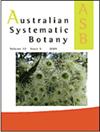Taxonomic revision of the Myosotis australis group (Boraginaceae) native to Australia, New Zealand and New Guinea
IF 1.6
3区 生物学
Q4 EVOLUTIONARY BIOLOGY
引用次数: 4
Abstract
Abstract. The three main aims of this study were to circumscribe the Myosotis australis R.Br. group, determine the taxonomic utility of pollen characters, and delimit species and revise their taxonomy using macro-morphological and palynological data. The M. australis group is here recircumscribed to comprise two species, M. saxatilis Petrie (Marlborough and Otago, New Zealand) and M. australis. Myosotis australis is a widespread, morphologically variable species with two subspecies. M. australis subsp. australis comprises all Australian and most New Zealand specimens, including M. mooreana Lehnebach, M. lytteltonensis (Laing & A.Wall) de Lange, and several white- or yellow-flowered tag-named taxa from New Zealand, whereas M. australis subsp. saruwagedica (Schltr. ex Brand) Meudt, Thorsen & Prebble, comb. et stat. nov. is endemic to New Guinea. The M. australis group can be distinguished from all other ebracteate-erect Myosotis plants sampled to date, including the Australian endemic, M. exarrhena F.Muell., by a suite of characters, i.e. included anthers, calyx with both retrorse and hooked trichomes, rosette leaf trichomes retrorse abaxially and oblique to the midrib adaxially, and leaf length : width ratio of >2 : 1. Other characters can distinguish the group from M. discolor Pers., M. arvensis (L.) Hill, and M. umbrosa Meudt, Prebble & Thorsen respectively. Pollen characters were not useful for species delimitation within the M. australis group, but they can help distinguish several species outside it, including natural hybrids of M. australis and M. exarrhena in Australia. Myosotis australis, M. saxatilis and M. exarrhena are included in the taxonomic treatment, whereas introduced species M. discolor and M. arvensis are included in the key only.标题原产于澳大利亚、新西兰和新几内亚的澳洲肌索属(Boraginaceae)的分类订正
摘要本研究的三个主要目的是确定南方Myosotis australis R.Br.群的界限,确定花粉特征的分类效用,并利用宏观形态学和孢粉学数据界定物种并修改其分类。澳大利亚M.australis群在这里被重新描述为包括两个物种,M.saxatilis Petrie(新西兰马尔伯勒和奥塔哥)和澳大利亚M.austaris。南方肌索是一个分布广泛、形态多变的物种,有两个亚种。南方M.australis亚种。australis包括所有澳大利亚和大多数新西兰标本,包括M.mooreana Lehnebach、M.lytteltonensis(Laing&A.Wall)de Lange和几个来自新西兰的白色或黄色标签命名分类群,而M.australis subsp。saruwagedica(Schltr.ex品牌)Meudt,Thorsen&Prebble,梳子。et stat.nov.是新几内亚的特有种。澳大利亚M.australis群可以通过一系列特征与迄今为止采样的所有其他无脊椎直立Myosotis植物区分开来,包括澳大利亚特有的M.exarrhena F.Muell.,即包括花药、具有反折和钩状毛状体的花萼、玫瑰花结叶毛状体背面反折和正面斜向中脉,叶长宽比>2:1。其他性状可以将该类群分别与M.discolor Pers.、M.arvensis(L.)Hill和M.umbrosa Meudt、Prebble和Thorsen区分开来。花粉特征对澳大利亚M.australis类群内的物种划分没有用处,但它们可以帮助区分它之外的几个物种,包括澳大利亚M.austarlis和M.exarrhena的天然杂交种。Myosotis australis、M.saxatilis和M.exarrhena被包括在分类处理中,而引入物种M.discolor和M.arvensis仅被包括在关键中。
本文章由计算机程序翻译,如有差异,请以英文原文为准。
求助全文
约1分钟内获得全文
求助全文
来源期刊

Australian Systematic Botany
生物-进化生物学
CiteScore
3.10
自引率
12.50%
发文量
12
审稿时长
>12 weeks
期刊介绍:
Australian Systematic Botany is an international journal devoted to the systematics, taxonomy, and related aspects of biogeography and evolution of all algae, fungi and plants, including fossils. Descriptive taxonomic papers should normally constitute a comprehensive treatment of a group. Short papers on individual species and nomenclatural papers must contain significant new information of broader interest to be considered. The prestigious L.A.S. Johnson Review Series is published. Other review articles will also be considered. All papers are peer reviewed.
Australian Systematic Botany is published with the endorsement of the Commonwealth Scientific and Industrial Research Organisation (CSIRO) and the Australian Academy of Science.
 求助内容:
求助内容: 应助结果提醒方式:
应助结果提醒方式:


